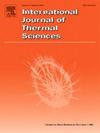Nanoparticle-enhanced bubble nucleation and heat transfer in nanoscale pool boiling
IF 4.9
2区 工程技术
Q1 ENGINEERING, MECHANICAL
International Journal of Thermal Sciences
Pub Date : 2025-04-03
DOI:10.1016/j.ijthermalsci.2025.109917
引用次数: 0
Abstract
Boiling heat transfer is well-known for its efficient multiphase properties and has been extensively studied. However, integrating nanofluids into boiling processes remains relatively underexplored, requiring a detailed understanding of their heat transfer characteristics. This work investigates the bubble behavior and heat transfer characteristics of deposited copper (Cu) nanoparticles on a platinum (Pt) heating substrate during pool boiling using molecular dynamics. Results show that bubbles initially nucleate on the Cu nanoparticle surface, coalesce from both sides and eventually form a vapor film. This film detaches from both the nanoparticle and the substrate. In a pure argon (Ar) system, bubbles nucleate directly on the substrate and detach immediately after coalescence. This leads to a 15.07 % increase in heat flux, a 13.7 % reduction in nucleate boiling onset time, and a 17.9 % increase in maximum evaporation. Among spherical, cylindrical, square, and conical deposited Cu nanoparticles, bubbles nucleate earliest at the edges of square nanoparticles, with nucleation occurring 8.7 % earlier and achieving 17.35 % higher maximum heat flux before nucleate boiling than in spherical nanoparticles. Additionally, nanoparticles with greater surface roughness and smaller specific surfaces favor bubble formation and growth. Ar vapor infiltrates the bubbles, enhancing buoyancy and promoting their detachment from the conductive layer. Moreover, weakened surface tension and lower surface energy facilitate bubble detachment. Resulting pores provide nucleation sites, enhancing vapor-liquid interaction and improving heat transfer efficiency.
纳米颗粒增强的纳米池沸腾气泡成核与传热
沸腾传热以其高效的多相特性而闻名,并得到了广泛的研究。然而,将纳米流体整合到沸腾过程中的探索相对较少,需要详细了解其传热特性。本文利用分子动力学方法研究了在铂加热基底上沉积的铜纳米颗粒在沸腾过程中的气泡行为和传热特性。结果表明:气泡最初在Cu纳米颗粒表面成核,然后从两侧聚结,最终形成气膜;这层薄膜可以从纳米颗粒和衬底上分离。在纯氩(Ar)体系中,气泡直接在基体上成核,并在结合后立即分离。这导致热通量增加15.07%,核沸腾开始时间减少13.7%,最大蒸发增加17.9%。在球形、圆柱形、方形和锥形Cu纳米颗粒中,方形纳米颗粒的边缘气泡成核最早,成核时间比球形纳米颗粒早8.7%,成核沸腾前最大热流密度比球形纳米颗粒高17.35%。此外,具有更大表面粗糙度和更小比表面的纳米颗粒有利于气泡的形成和生长。氩气渗入气泡,增强浮力,促进气泡脱离导电层。表面张力减弱,表面能降低,有利于气泡脱离。由此产生的孔隙提供了成核位置,增强了汽液相互作用,提高了传热效率。
本文章由计算机程序翻译,如有差异,请以英文原文为准。
求助全文
约1分钟内获得全文
求助全文
来源期刊

International Journal of Thermal Sciences
工程技术-工程:机械
CiteScore
8.10
自引率
11.10%
发文量
531
审稿时长
55 days
期刊介绍:
The International Journal of Thermal Sciences is a journal devoted to the publication of fundamental studies on the physics of transfer processes in general, with an emphasis on thermal aspects and also applied research on various processes, energy systems and the environment. Articles are published in English and French, and are subject to peer review.
The fundamental subjects considered within the scope of the journal are:
* Heat and relevant mass transfer at all scales (nano, micro and macro) and in all types of material (heterogeneous, composites, biological,...) and fluid flow
* Forced, natural or mixed convection in reactive or non-reactive media
* Single or multi–phase fluid flow with or without phase change
* Near–and far–field radiative heat transfer
* Combined modes of heat transfer in complex systems (for example, plasmas, biological, geological,...)
* Multiscale modelling
The applied research topics include:
* Heat exchangers, heat pipes, cooling processes
* Transport phenomena taking place in industrial processes (chemical, food and agricultural, metallurgical, space and aeronautical, automobile industries)
* Nano–and micro–technology for energy, space, biosystems and devices
* Heat transport analysis in advanced systems
* Impact of energy–related processes on environment, and emerging energy systems
The study of thermophysical properties of materials and fluids, thermal measurement techniques, inverse methods, and the developments of experimental methods are within the scope of the International Journal of Thermal Sciences which also covers the modelling, and numerical methods applied to thermal transfer.
 求助内容:
求助内容: 应助结果提醒方式:
应助结果提醒方式:


